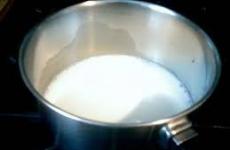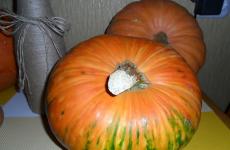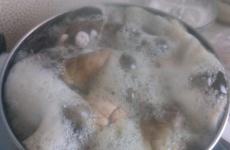Alexey Leonov. First space walker
("Le Temps", Switzerland) Olga Yurkina
On March 18, 1965, Soviet cosmonaut Alexei Leonov became the first person to walk into outer space. It happened four years after the flight of Gagarin, who became the first man in space, but did not leave the limits of his ship. Ten years later at the height cold war another historic mission fell to his lot: he shook hands with American astronaut Thomas Stafford during the first space meeting of two nations.
Sometimes the life of an astronaut literally hangs on a string. Well, or on a cable that insured Alexei Leonov during the first spacewalk. On March 18, 1965, for the first time in the history of mankind, he soared at an altitude of 500 kilometers above the Earth, alone against the backdrop of the gaping abyss of outer space. For those 12 long minutes Soviet hero I had to go against the rules to save my life.
“I didn’t have fear. Just curiosity. I think the first thing I said was: “And the Earth is really round,” says this 80-year-old man, who resembles a retired general. Now it’s pouring rain in Star City. Alexey Leonov meets us at the cosmonaut training center, where the adventure of a young and courageous pilot began, who was selected for the first group of cosmonauts in 1960. And space missions ended 30 years later, when he had to step down as deputy director.
"I saw the Black Sea, a little further Romania, Italy ... The Earth was a huge ball, the continents and rivers were perfectly visible ..." Aleksey Leonov's gaze clears up with these memories. When he got out spaceship"Voskhod-2", then began to rotate, and then flew away from him. He was able to admire the lights of Rio de Janeiro and the sparkling network of roads around the cities. But it wasn't just the Earth that caught my eye: the sky was filled with stars. "Space was very quiet. I could hear my heartbeat, heavy breathing..." This labored breathing (Stanley Kubrick used it in his 2001 Space Odyssey) was due to the design of the suit, which provided the astronaut with only 60 liters of oxygen (today the norm is 300 liters). However, another unpleasant surprise awaited the first space walker, which nearly cost him his life.
"Unexpected pressure problems arose: the suit began to deform and swell. The hands flew out of the gloves, and the legs flew out of the boots, as if I myself had become smaller. There were no mechanisms then to adjust the suit, as they are now." So what to do? Act and act quickly. There were still five minutes left before falling into the shade, an impenetrable night with a temperature of -140 degrees. I needed my fingers to get back on the ship. I saw only one solution. "He did not contact the management contrary to all protocols and decided to reduce the pressure in the suit by half, which was a very risky step. The first serious violation. When the suit contracted again, he was able to move again. he no longer had the strength to do it feet first, as required by the rules, he entered the capsule head first, which was already the second violation.
Upon his return to Earth, after eulogies and parades in his honor, he was demanded an explanation. Alexei Leonov seems to be reliving that scene again: “I told them: “Imagine that I would report to you about everything. You would call a committee to discuss. It would take five minutes. Then you would have to choose the chairman of the commission. Two more minutes. Then you would start a discussion and take a vote. And in the end, they would have advised me to reduce the pressure in the spacesuit ... But then I would not have been able to do this. " His boss smiled broadly: "But Alexei is right!" The astronaut was not only forgiven, but also earned respect.
In 1973, he was assigned another historic mission: to conduct the first space rendezvous of Soviet and American spacecraft, the Soyuz-Apollo program. This project, which was supposed to serve to defuse international relations at the height of the Cold War, seemed like madness. “The four people who initiated this meeting were, it seems to me, citizens of the universe: President Richard Nixon, Minister Alexei Kosygin, NASA Director James Fletcher and our space center physicist Mstislav Keldysh. countries could be something different, something higher. They sought to put off the threat of the Third World War. And we, astronauts, had to serve together, to show that peaceful cooperation is possible."
The launch was scheduled for July 15, 1975. According to the scenario, Alexei Leonov's historic handshake with American crew commander Tom Stafford was to take place in the sky high above Moscow. However, space has changed the alignment. “At some point, there must have been a desynchronization. I still didn’t understand how. But we ended up shaking hands a little earlier than expected, right above the Elbe, where Soviet and American troops met in 1945. Also symbolic It wasn't meant to be, but it ended up being prettier and smarter than it was planned."
However, another plan worked perfectly: Aleksey Leonov drew fake vodka labels and pasted them on tubes of borscht to mark the scientific collaboration. The Americans appreciated the joke. Drawing has always been another passion of Leonov. He was enrolled in an art school, but shortly before the start of classes, he nevertheless exchanged it for a career as a pilot. Nevertheless, he did not lose his love for the brush and drew inspiration from flights, recreating the colors of the cosmos, so unlike the earthly ones. These cosmic colors captured his imagination. He even created special tools for studying them and did this in his spare time. "I made two observations. When you move from light to shadow, the picture begins to resemble Rockwell Kent, the cold and pure colors of Alaska. When you come out of the night into the sun, the warm colors of Nicholas Roerich are all around."
Subsequently, he proposed a design for a globe in its true colors, as seen from space. In addition, he developed his own method of drawing the starry sky. "Star clusters are so amazing that you don't even need to invent anything here, it's enough just to depict the landscape of the night sky, the northern lights with their blue-green and red stains ..." But then the general comes to replace the artist again. Finally, he talks about preparing for the flight to the moon. The program was stopped, and he never managed to make this legendary step. So he drew a man on the Earth's satellite. For him, it was a continuation of the dream of space.
Original publication: Il y a 50 ans, le premier pieton de l "espace
Inosmi
Last week in Tisul hosted a famous countryman - cosmonaut Alexei Leonov. This time he arrived in his small homeland not alone, but with a director from France, who is making a film for European television called "Alexey Leonov - a space pedestrian."
law of attraction
On Cosmic Street in the village of Listvyanka, the house where Aleksey Leonov was born still stands to this day. An ordinary log hut with blue shutters and white lace curtains on the windows. A family that is not related to Leonov's family now lives here, but over many years of acquaintance they have become like relatives to the famous countryman. Aleksey Leonov was treated to bread and salt at the entrance to the district: right on the road they offered both a loaf and tea, and sang songs to the guest to the accordion. And at home, the table from the village dishes was literally bursting. Aleksey Arkhipovich led all the guests (jokingly, he specified that we were visiting, and he was at home) into one of the rooms and pointed to a hook on the ceiling, on which his unsteady 76 years ago hung. The future cosmonaut was the ninth child in the family. It was from this house that the Leonovs moved to Kemerovo, and then to Kaliningrad. “When I was taken away from here,” recalls Alexei Arkhipovich, “I was not even three years old, it was a harsh time. But somewhere subtly, somewhere in the subcortex, I imagined these hills, this river of childhood. I remember two logs on the river, along which I walked, and when I came here for the first time as an adult, I saw these places, everything was restored to my memory again. And every time I return from Kuzbass, this charge from my native places and from the cleanliness of the people who live here, from communicating with them, from their kindness and integrity, is enough for me for several months. I like to visit Listvyanka, there is breadth and space.
The world will know its heroes
Vladimir Kozlov, the author of the future film, which is being shot for French and Belgian television, literally does not leave Alexei Leonov. He is interested in everything: the personal life of an astronaut, gastronomic preferences, passion for painting. It is planned to be ready in January next year. Moreover, the producers and creators of the tape are sure that all European countries and the USA will want to buy it. Overseas have already become interested in the project, they promised help - to provide materials about Leonov's stay in America. - There are only four cosmonauts known throughout the world: Yuri Gagarin, Valentina Tereshkova, Neil Armstrong and Alexei Leonov, - says Vladimir Kozlov. – Quite recently it was 35 years since the Apollo-Soyuz flight, and we filmed Thomas Stafford and Leonov at the American embassy and at Sheremetyevo-2. It was very touching. The film is biographical using materials from the family archive of Alexei Arkhipovich, which have never been published before. I take it everywhere: at home, at work, on the road. I come up with different things, for example, I plan such a scene: in Moscow, where there are usually a lot of traffic jams, he starts swearing and saying what Russians usually say in such cases. I provoke him a little to revelations. I want him to say more about himself than in other films. During work, I asked him what was the worst thing for an astronaut, did he see aliens in space, and he said that the worst thing for an astronaut (which touched me very much) is a small meteorite, one, two or three millimeters, which can break through duralumin ship hull. And so they were afraid of this "alien" more than anything else. Filming is difficult, because Alexey Arkhipovich is very busy, and we shoot a day or two a month (and we started in April). It is a great honor for me to make this film, because Leonov is the hero of my childhood. He is known as an astronaut, and he is also a wonderful artist, public figure, amazing reader, he speaks beautifully, he tells his life like a fairy tale, so the children just listen. In general, he has so many advantages, it's just incredible! Painfully many-sided portrait is obtained, incredible dimensions. I feel that I can’t take it all off, it’s unexpected, completely amazing, touching.
“So that you are not lost on earth ...”
In the Tisul art school, which bears the name of the cosmonaut (and was opened with his support), Alexei Leonov, according to the established tradition, gives a master class for children on the day of arrival. He talks about painting more than about space, although he draws spaceships for children, talks about their structure and flights. “Drawing is the source and root of all science,” Alexei Arkhipovich quotes the words of the great Michelangelo. Along the way, he wonders if the children know who Sergei Pavlovich Korolev is, and what was the name of the first spaceship on which Yuri Gagarin flew into space. To which the guys together promise to carefully study at least the information in the encyclopedia. Aleksey Arkhipovich also admitted that in childhood, like everyone else, he sometimes treated his studies with laziness, and warned that later he would have to make up for lost time, so it’s better to do everything on time. Since childhood, Aleksey Leonov dreamed of becoming an artist. At school, he traded watercolors and a book with images of Aivazovsky's paintings for several rations (1 ration - a piece of bread weighing 50 grams and a spoonful of sugar), gave it away for a whole month, and he himself remained hungry. During the war, from the Ogonyok magazine, which his mother loved and subscribed to, Leonov cut out reproductions of paintings - this is how the entire Tretyakov Gallery appeared at home. In his youth, Leonov tried to enter the Riga Academy of Arts, but in the post-war period he simply did not have enough money to live in the capital city. Then I decided to become a pilot. However, brushes and a sketchbook still “accompany” Alexei Leonov, he paints paintings where two themes prevail: space and nature. Children ask questions, are interested in his favorite artists and paintings, and Alexei Arkhipovich talks with pleasure about Ivan Aivazovsky, Valentin Serov, Pablo Picasso. By the way, he was personally acquainted with the latter, and once he had a chance to dine with the great artist. At that meeting, Picasso showed his talent on the skeleton of a fish, making a composition out of it. Alexei Leonov shows (draws on a sheet) how quickly, under him, Picasso also depicted his famous Dove of Peace. With special enthusiasm and even tenderness, the astronaut talks about colors and paints. By the way, the most favorite color of Alexei Arkhipovich is a combination of blue and black, this can be seen in his works. Today Leonov is a recognized master, a member of the Russian Academy of Arts. - As they say, do not be proud, - Alexey Arkhipovich laughs. - I think that everything I wanted in life - I achieved it. When I was still at school, I kept a diary, and in the diary was written (I don’t know, I myself invented it or read it somewhere) the epigraph: “My fate is my own.” And this is my whole life. There is even a song like this: so that people don’t lose you, try not to lose yourself.
http://www.i2n.ru/news/society/11751/
Alexei Arkhipovich Leonov is a test pilot, cosmonaut, artist, the first earthling who went into outer space, winner of many prizes and awards.
Childhood and youth
Alexei Leonov was born on May 30, 1934 in the village of Listvyanka. His grandfather was exiled here for participation in the events of 1905, a little later, the parents of the future cosmonaut, who had previously lived in the Donbass, also moved to Siberia. Alexei's father, Arkhip Alekseevich, had to change the profession of a miner to a peasant share, and his mother, Evdokia Minaevna, worked as a teacher.
There were many children in the Leonov family, Lesha himself is the youngest, the ninth child in a row. Family happiness and life were violated by Stalin's repressions. In 1936, Arkhip Leonov, a respected man, chairman of the village council, was arrested on false charges. The wife and children of the authorities were deprived of property and expelled from the house, and the children were forbidden to go to school. Fortunately, Leonov Sr. managed to survive in the camps, and in 1939 the father of a large family was acquitted and returned home.

By that time, Evdokia Minaevna, desperate to feed her children alone, having lost her job and shelter, moved to Kemerovo, to her eldest daughter. She had a room in the barracks, where for about a year the large Leonov family huddled. A year later, the father returned, and the family slowly began to rise to its feet. First, they were given two more rooms in the same barracks, and in 1948 Arkhip Alekseevich was assigned to a new job in Kaliningrad, where the Leonovs moved.
By the will of fate, little Alyosha went to school only at the age of 9, in Kemerovo. AT primary school the boy became interested in drawing. At first he saw an album with black-and-white reproductions from a classmate, and soon became addicted to the art of painting stoves. He learned the latter from immigrants from Ukraine, who also moved to Siberia.

high school Alyosha graduated already in Kaliningrad. By the time he received his certificate in 1953, Alexei had fully mastered the design of aircraft engines, aircraft and the theory of flight. The young man received this knowledge by reading the notes of his older brother, who once studied as an aviation technician.
1953 was a turning point in the biography and fate of the future cosmonaut: he hesitated in choosing professions between art and aviation. Aleksey applied to the Riga Academy of Arts, but after learning that students are provided with a hostel only from the third year of study, he left the first year.
astronautics
After the failure with the Academy of Arts, Leonov entered the primary aviation school in Kremenchug, where the Komsomol recruitment was just being carried out. Upon completion of training in 1955, the young pilot continued his education at the Chuguev Aviation School, where he received the specialty of a fighter pilot. After graduating from college from 1957 to 1959, Alexei Leonov served in the tenth Guards Aviation Division in Kremenchug, from 1959 to 1960 - in Germany, as part of the Soviet troops.

In the autumn of 1959, Alexei Arkhipovich was destined to once again drastically change his fate. It was then that he met the head of the Cosmonaut Training Center (CTC), Colonel Karpov. At the first selection committee in Sokolniki, Leonov first met with, with whom he subsequently had a strong friendship.

In 1960, Alexei Leonov was enrolled in a special detachment. This was followed by CPC courses and countless training sessions. In 1964, a design bureau led by Korolev began building a new spacecraft that would allow astronauts to go out into the airless space. This ship was Voskhod-2.
Two crews were preparing for the flight. The main staff included Alexei Lenov and, their understudies were cosmonauts Khrunov and Gorbatko. The historic flight and the first manned spacewalk took place on March 18, 1965.

After the flight on Voskhod-2, Leonov was part of a group of cosmonauts who were trained for flight and landing on the moon, but in the end the program was closed. The next exit of Leonov into the earth's orbit took place in 1975, when the legendary docking of the Soviet Soyuz-19 spacecraft and the American Apollo was made.
In 1982-1991, Leonov was the first deputy head of the CPC, in 1992 he retired.
First spacewalk
The launch of the spacecraft from Baikonur was successful, and then the flight proceeded in the normal mode. It was planned that "Vostok-2" should make seventeen turns around the Earth. On the second orbit, Leonov was supposed to enter the airless space through a special airlock. That's how it all happened. Alexei's partner, the captain of the ship, Pavel Belyaev, remained on board and watched what was happening with the help of television cameras.

Alexey Leonov spent in open space 12 minutes 9 seconds. The astronaut was filmed by two static cameras, another camera was in his hands. Along with the delight of what he saw and the significance of the accomplished feat, Alexei Arkhipovich also experienced unpleasant sensations.
It was unbearably hot in the spacesuit, sweat flooded his eyes, the astronaut began to have tachycardia, and his temperature rose. When returning to the ship, there were also problems. From being in a vacuum, Leonov's spacesuit swelled up, and it was impossible to squeeze through the opening of the airlock. The hero had to relieve pressure so that the volume of the suit returned to normal. With his hands full of camera and tether, it wasn't easy.
Finally, the astronaut got into the airlock, but then another trouble awaited him. When the lock chamber was disconnected, the ship was depressurized. It was possible to solve this problem by supplying oxygen, as a result of which the crew began to oversaturate with oxygen.
Having dealt with the malfunctions, the astronauts prepared to make an automatic landing in the normal mode, but that was not to be. The ship was supposed to go down on the seventeenth orbit around the Earth, but the system failed. Pavel Belyaev had to urgently take control. The captain kept within 22 seconds, but this time difference was enough for the crew to land 75 kilometers from the planned place. It happened two hundred kilometers from Perm, in the taiga, which made it very difficult for the search engines to work.

After four hours in the snow, in the cold, the astronauts were found by rescuers. The heroes were helped to get to the nearest wooden house in the forest, then they cleared a platform for a helicopter landing, and only two days later the crew of Vostok-2 was safely evacuated and transported to Moscow.
Personal life
Alexei Arkhipovich Leonov met his future wife, Svetlana, in 1957. Three days after they met, they got married so as not to leave. The Leonovs had two daughters.

The eldest daughter Victoria (1961-1996) died from a severe sudden illness. The woman worked in the main department of the navy, and after returning from a business trip to America, she suddenly felt ill. Parents took their daughter to the capital's doctors, but they could not help. Victoria died of a severe form of hepatitis complicated by pneumonia.

Youngest daughter Alexei and Svetlana Leonov, Oksana, was born in 1967. She works as a translator, is married, thanks to Oksana, the Leonovs have two grandchildren.
Until 2000, Leonov served as president of the Alfa Capital investment fund, then became vice president of the bank with the same name. Now the cosmonaut lives near Moscow, in a house designed by himself.

In addition to astronautics, Alexei Arkhipovich is also known as an artist. In adulthood, he found the same time for children's passion. Leonov is the author of two hundred paintings and five albums with reproductions. Among his works are cosmic and terrestrial landscapes, portraits of friends, fantastic stories. Leonov the artist likes to work in oils, watercolors and Dutch gouache.

Also Hero Soviet Union enjoys reading, cycling, fencing, hunting, tennis, basketball, photography and filming. Such activity and energy are surprising, considering how old Alexei Leonov is (almost 83 years old).

In 2017, the film "The Time of the First" was released on the screens of the country, dedicated to the exploits and everyday life of the Soviet cosmonautics, with and in the lead roles.
Actors and Alexei Leonov himself, who advised the film crew at various stages, were invited to Malakhov’s program “Tonight”, timed to coincide with the release of the tape.
Merits
Alexey Arkhipovich is a holder of dozens of domestic and foreign awards, orders, and medals. The cosmonaut is an honorary citizen of 30 cities of the world, a member of the International Academy of Astronautics, an academician of the Russian Academy of Astronautics, he is a candidate of technical sciences.

- the development of a hydrolaboratory and the creation of a spacesuit for working in the hydrosphere (1966);
- study of light and color characteristics of vision after space flight (1967);
- influence of factors space flight on the visual acuity of the pilot of the complex "Buran" (1980).
Bibliography
On account of Alexei Leonov books and scientific publications, including:
- Space Pedestrian (1967);
- "Solar Wind" (1969);
- "Going out into outer space" (1970);
- "Features of the psychological preparation of astronauts" (1967).






